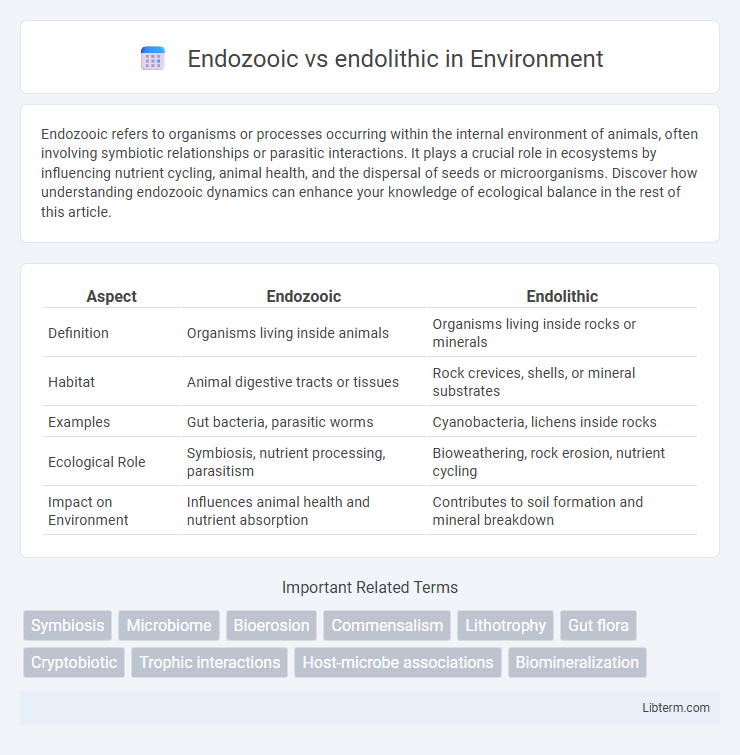Endozooic refers to organisms or processes occurring within the internal environment of animals, often involving symbiotic relationships or parasitic interactions. It plays a crucial role in ecosystems by influencing nutrient cycling, animal health, and the dispersal of seeds or microorganisms. Discover how understanding endozooic dynamics can enhance your knowledge of ecological balance in the rest of this article.
Table of Comparison
| Aspect | Endozooic | Endolithic |
|---|---|---|
| Definition | Organisms living inside animals | Organisms living inside rocks or minerals |
| Habitat | Animal digestive tracts or tissues | Rock crevices, shells, or mineral substrates |
| Examples | Gut bacteria, parasitic worms | Cyanobacteria, lichens inside rocks |
| Ecological Role | Symbiosis, nutrient processing, parasitism | Bioweathering, rock erosion, nutrient cycling |
| Impact on Environment | Influences animal health and nutrient absorption | Contributes to soil formation and mineral breakdown |
Understanding Endozooic and Endolithic Relationships
Endozooic organisms live inside animals, often benefiting from symbiotic relationships that aid in nutrient exchange and habitat stability, while endolithic organisms inhabit the interior of rocks, coral, or shells, contributing to bioerosion and mineral cycling in ecosystems. Understanding these relationships involves studying how endozooic microbes influence host digestion and immunity, contrasted with how endolithic microbes modify geological substrates and impact marine or terrestrial habitats. These interactions reveal critical ecological roles in nutrient dynamics, habitat formation, and ecosystem resilience.
Definitions: What Does Endozooic Mean?
Endozooic refers to organisms or biological processes occurring inside animals, particularly involving the dispersal or habitation within an animal's body. Endolithic describes organisms that live inside rocks, coral skeletons, or other calcareous substrates, often boring into these materials for shelter and survival. The key distinction is that endozooic pertains to internal animal environments, while endolithic relates to life within mineral or skeletal structures.
Defining Endolithic: Life Within Rocks
Endolithic organisms live inside rocks, penetrating mineral substrates to survive in extreme environments where light and nutrients are scarce. These microscopic life forms include bacteria, fungi, and algae that exploit cracks and pores in rocks, enabling them to withstand harsh conditions such as deserts or polar regions. By contrast, endozooic organisms inhabit animal bodies, relying on hosts rather than mineral habitats for survival.
Key Differences Between Endozooic and Endolithic Organisms
Endozooic organisms live inside the bodies of animals, such as gut bacteria and parasites, relying on a host for nutrients and protection. Endolithic organisms inhabit the interior of rocks, minerals, or coral skeletons, adapting to extreme environments with limited light and nutrients. The key difference lies in habitat preference: endozooic organisms depend on animal hosts, whereas endolithic species thrive within inorganic substrates.
Ecological Roles of Endozooic Species
Endozooic species play a crucial ecological role by facilitating seed dispersal and nutrient cycling through their interactions within animal digestive systems. These organisms contribute to plant population dynamics and ecosystem regeneration by enhancing germination rates and distribution patterns. Their symbiotic relationships influence biodiversity and habitat stability across various terrestrial and aquatic ecosystems.
Adaptive Strategies of Endolithic Microorganisms
Endolithic microorganisms exhibit adaptive strategies such as biofilm formation and mineral dissolution to penetrate and inhabit rock substrates, enabling survival in extreme environments with limited nutrients and moisture. These adaptations contrast with endozooic microorganisms, which specialize in residing within animal hosts and rely on host-derived nutrients and protected internal environments. Endolithic microbes optimize energy use through slow metabolic rates and utilize rock microenvironments for protection against UV radiation and desiccation, demonstrating unique ecological versatility.
Examples of Endozooic Organisms in Nature
Endozooic organisms live inside the bodies of animals, benefiting from internal habitats, with examples including gut bacteria like Escherichia coli in mammals and protozoa such as Trichonympha in termite guts aiding digestion. In contrast, endolithic organisms inhabit the interior of rocks or coral skeletons, such as cyanobacteria in marine environments and fungi within limestone. Understanding these distinct ecological niches highlights the diverse adaptations of microorganisms to internal biological versus mineral substrates.
Notable Endolithic Life Forms and Habitats
Endolithic life forms, including cyanobacteria, algae, and lichens, inhabit the microscopic pores and crevices within rocks and mineral substrates, thriving in extreme environments such as deserts, polar regions, and deep oceanic crusts. These organisms contribute to bio-weathering and nutrient cycling by colonizing substrates like limestone, basalt, and sandstone in habitats characterized by high UV radiation, desiccation, and temperature fluctuations. Unlike endozooic organisms that live inside animals, endolithic species are crucial for understanding extremophile survival strategies and the potential for life on extraterrestrial rocky surfaces.
Environmental Significance and Impact
Endozooic organisms, which live inside animals, play a crucial role in nutrient cycling and seed dispersion within ecosystems, enhancing biodiversity and promoting plant regeneration. Endolithic organisms inhabit rock substrates, contributing to biological weathering and mineral cycling, which aid in soil formation and ecosystem stability. Both types support ecosystem resilience by facilitating key environmental processes, but endolithic communities are particularly important in extreme environments where other life forms struggle to survive.
Endozooic vs Endolithic: Future Research Directions
Endozooic and endolithic symbioses present unique ecological adaptations with distinct host environments influencing microbial community composition and function. Future research directions should emphasize high-resolution genomic and metabolomic analyses to unravel the molecular mechanisms driving host specificity and nutrient exchange in these habitats. Integrating environmental DNA sequencing with advanced imaging techniques will enhance understanding of spatial distribution patterns and evolutionary dynamics within endozooic and endolithic systems.
Endozooic Infographic

 libterm.com
libterm.com